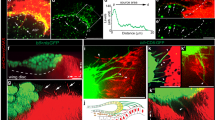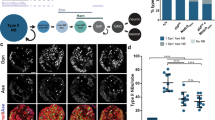Abstract
The anterior/posterior (A/P) and dorsal/ventral (D/V) compartment borders that subdivide the wing imaginal discs of Drosophila third instar larvae are each associated with a developmental organizer. Decapentaplegic (Dpp), a member of the transforming growth factor-β (TGF-β) superfamily, embodies the activity of the A/P organizer. It is produced at the A/P organizer and distributes in a gradient of decreasing concentration to regulate target genes, functioning non-autonomously to regulate growth and patterning of both the anterior and posterior compartments1,2,3. Wingless (Wg) is produced at the D/V organizer and embodies its activity4,5. The mechanisms that distribute Dpp and Wg are not known, but proposed mechanisms include extracellular diffusion6, successive transfers between neighbouring cells7,8, vesicle-mediated movement9, and direct transfer via cytonemes10. Cytonemes are actin-based filopodial extensions that have been found to orient towards the A/P organizer from outlying cells. Here we show that in the wing disc, cytonemes orient towards both the A/P and D/V organizers, and that their presence and orientation correlates with Dpp signalling. We also show that the Dpp receptor, Thickveins (Tkv), is present in punctae that move along cytonemes. These observations are consistent with a role for cytonemes in signal transduction.
This is a preview of subscription content, access via your institution
Access options
Subscribe to this journal
Receive 51 print issues and online access
$199.00 per year
only $3.90 per issue
Buy this article
- Purchase on Springer Link
- Instant access to full article PDF
Prices may be subject to local taxes which are calculated during checkout





Similar content being viewed by others
References
Basler, K. & Struhl, G. Compartment boundaries and the control of Drosophila limb pattern by hedgehog protein. Nature 368, 208–214 (1994)
Tabata, T. & Kornberg, T. B. Hedgehog is a signalling protein with a key role in patterning Drosophila imaginal discs. Cell 76, 89–102 (1994)
Tabata, T. & Takei, Y. Morphogens, their identification and regulation. Development 131, 703–712 (2004)
Neumann, C. J. & Cohen, S. M. A hierarchy of cross-regulation involving Notch wingless, vestigial and cut organizes the dorsal/ventral axis of the Drosophila wing. Development 122, 3477–3485 (1996)
Zecca, M., Basler, K. & Struhl, G. Direct and long-range action of a wingless morphogen gradient. Cell 87, 833–844 (1996)
Strigini, M. & Cohen, S. M. Wingless gradient formation in the Drosophila wing. Curr. Biol. 10, 293–300 (2000)
Kerszberg, M. & Wolpert, L. Mechanisms for positional signalling by morphogen transport: a theoretical study. J. Theor. Biol. 191, 103–114 (1998)
Entchev, E. V., Schwabedissen, A. & Gonzalez-Gaitan, M. Gradient formation of the TGF-β homolog Dpp. Cell 103, 981–991 (2000)
Panakova, D., Sprong, H., Marois, E., Thiele, C. & Eaton, S. Lipoprotein particles are required for Hedgehog and Wingless signalling. Nature 435, 58–65 (2005)
Ramirez-Weber, F. A. & Kornberg, T. B. Cytonemes: cellular processes that project to the principal signalling center in Drosophila imaginal discs. Cell 97, 599–607 (1999)
Sato, M. & Saigo, K. Involvement of pannier and u-shaped in regulation of decapentaplegic-dependent wingless expression in developing Drosophila notum. Mech. Dev. 93, 127–138 (2000)
Moreno, E., Basler, K. & Morata, G. Cells compete for Decapentaplegic survival factor to prevent apoptosis in Drosophila wing development. Nature 416, 755–759 (2002)
Nellen, D., Burke, R., Struhl, G. & Basler, K. Direct and long-range action of a DPP morphogen gradient. Cell 85, 357–368 (1996)
Zigmond, S. H. Recent quantitative studies of actin filament turnover during cell locomotion. Cell Motil. Cytoskeleton 25, 309–316 (1993)
Kranewitter, W. J., Danninger, C. & Gimona, M. GEF at work: Vav in protruding filopodia. Cell Motil. Cytoskeleton 49, 154–160 (2001)
Teleman, A. A. & Cohen, S. M. Dpp gradient formation in the Drosophila wing imaginal disc. Cell 103, 971–980 (2000)
Ribeiro, C., Ebner, A. & Affolter, M. In vivo imaging reveals different cellular functions for FGF and Dpp signalling in tracheal branching morphogenesis. Dev. Cell 2, 677–683 (2002)
Wolf, C., Gerlach, N. & Schuh, R. Drosophila tracheal system formation involves FGF-dependent cell extensions contacting bridge cells. EMBO Rep. 3, 563–568 (2002)
Sato, M. & Kornberg, T. B. FGF is an essential mitogen and chemoattractant for the air sacs of the Drosophila tracheal system. Dev. Cell 3, 195–207 (2002)
De Joussineau, C. et al. Delta-promoted filopodia mediate long-range lateral inhibition in Drosophila. Nature 426, 555–559 (2003)
Chou, Y. H. & Chien, C. T. Scabrous controls ommatidial rotation in the Drosophila compound eye. Dev. Cell 3, 839–850 (2002)
Akiyama-Oda, Y. & Oda, H. Early patterning of the spider embryo: a cluster of mesenchymal cells at the cumulus produces Dpp signals received by germ disc epithelial cells. Development 130, 1735–1747 (2003)
Lidke, D. S. et al. Quantum dot ligands provide new insights into erbB/HER receptor-mediated signal transduction. Nature Biotechnol. 22, 198–203 (2004)
Brand, A. H. & Perrimon, N. Targeted gene expression as a means of altering cell fates and generating dominant phenotypes. Development 118, 401–415 (1993)
Acknowledgements
We gratefully acknowledge many helpful discussions with G. Ehrenkaufer, and thank K. Moses, E. Bier, L. Luo, and F. Chanut for fly stocks. This work was supported by a grant from the NIH to T.B.K.
Author information
Authors and Affiliations
Corresponding author
Ethics declarations
Competing interests
Reprints and permissions information is available at npg.nature.com/reprintsandpermissions. The authors declare no competing financial interests.
Supplementary information
Supplementary Tables S1 and S2
Supplementary Table S1: regional differences of cytoneme length in the wing disc. Supplementary Table S2: distribution of Tkv:GFP punctae in flattened and unflattened wing discs. (DOC 31 kb)
Supplementary Figure S1
Profiles of uncompressed and compressed wing discs. (PDF 961 kb)
Supplementary Figure Legend
Full text description of the above Supplementary Figure. (DOC 19 kb)
Supplementary Video S1
Punctae are motile, moving in both anterograde and retrograde directions and associate with cytonemes. (MOV 3527 kb)
Rights and permissions
About this article
Cite this article
Hsiung, F., Ramirez-Weber, FA., David Iwaki, D. et al. Dependence of Drosophila wing imaginal disc cytonemes on Decapentaplegic. Nature 437, 560–563 (2005). https://doi.org/10.1038/nature03951
Received:
Accepted:
Issue Date:
DOI: https://doi.org/10.1038/nature03951
This article is cited by
-
Regulatory mechanisms of cytoneme-based morphogen transport
Cellular and Molecular Life Sciences (2022)
-
Asymmetric requirement of Dpp/BMP morphogen dispersal in the Drosophila wing disc
Nature Communications (2021)
-
Generation of extracellular morphogen gradients: the case for diffusion
Nature Reviews Genetics (2021)
-
From top to bottom: Cell polarity in Hedgehog and Wnt trafficking
BMC Biology (2018)
-
Contextual determinants of TGFβ action in development, immunity and cancer
Nature Reviews Molecular Cell Biology (2018)
Comments
By submitting a comment you agree to abide by our Terms and Community Guidelines. If you find something abusive or that does not comply with our terms or guidelines please flag it as inappropriate.



